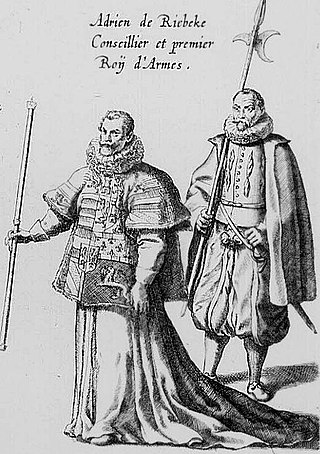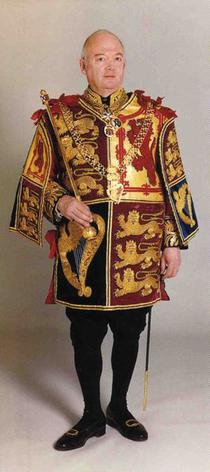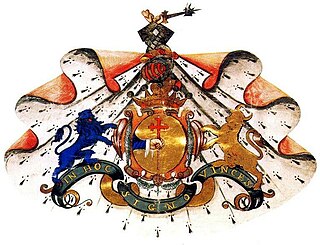
A coat of arms is a heraldic visual design on an escutcheon, surcoat, or tabard. The coat of arms on an escutcheon forms the central element of the full heraldic achievement, which in its whole consists of a shield, supporters, a crest, and a motto. A coat of arms is traditionally unique to the armiger. The term "coat of arms" itself, describing in modern times just the heraldic design, originates from the description of the entire medieval chainmail "surcoat" garment used in combat or preparation for the latter.

The Genealogical Office is an office of the Government of Ireland containing genealogical records. It includes the Office of the Chief Herald of Ireland, the authority in Ireland for heraldry. The Chief Herald authorises the granting of arms to Irish bodies and Irish people, including descendants of emigrants. The office was constituted on 1 April 1943 as successor to the Ulster King of Arms, established during the Tudor period of the Kingdom of Ireland in 1552. The Ulster King of Arms' duties in relation to Northern Ireland were taken over by the Norroy and Ulster King of Arms.

The Most Illustrious Order of Saint Patrick is a dormant British order of chivalry associated with Ireland. The Order was created in 1783 by King George III at the request of the then Lord Lieutenant of Ireland, The 3rd Earl Temple. The regular creation of knights of the Order lasted until 1922, when most of Ireland gained independence as the Irish Free State, a dominion within what was then known as the British Commonwealth of Nations. While the Order technically still exists, no knight of St Patrick has been created since 1936, and the last surviving knight, Prince Henry, Duke of Gloucester, died in 1974. Charles III, however, remains the Sovereign of the Order, and one officer, the Ulster King of Arms, also survives. St Patrick is patron of the order; its motto is Quis separabit?, Latin for "Who will separate [us]?": an allusion to the Vulgate translation of Romans 8:35, "Who shall separate us from the love of Christ?"

The Right Honourable the Lord Lyon King of Arms, the head of Lyon Court, is the most junior of the Great Officers of State in Scotland and is the Scottish official with responsibility for regulating heraldry in that country, issuing new grants of arms, and serving as the judge of the Court of the Lord Lyon, the oldest heraldic court in the world that is still in daily operation.

The College of Arms, or Heralds' College, is a royal corporation consisting of professional officers of arms, with jurisdiction over England, Wales, Northern Ireland and some Commonwealth realms. The heralds are appointed by the British Sovereign and are delegated authority to act on behalf of the Crown in all matters of heraldry, the granting of new coats of arms, genealogical research and the recording of pedigrees. The College is also the official body responsible for matters relating to the flying of flags on land, and it maintains the official registers of flags and other national symbols. Though a part of the Royal Household of the United Kingdom, the College is self-financed, unsupported by any public funds.

An officer of arms is a person appointed by a sovereign or state with authority to perform one or more of the following functions:

King of arms is the senior rank of an officer of arms. In many heraldic traditions, only a king of arms has the authority to grant armorial bearings and sometimes certify genealogies and noble titles. In other traditions, the power has been delegated to other officers of similar rank.

The coat of arms of Ireland is blazoned as Azure a harp Or, stringed Argent. These arms have long been Ireland's heraldic emblem. References to them as being the arms of the king of Ireland can be found as early as the 13th century. These arms were adopted by Henry VIII of England when he ended the period of Lordship of Ireland and declared Ireland to be a kingdom again in 1541. When the crowns of England, Scotland and Ireland were united in 1603, they were integrated into the unified royal coat of arms of kingdoms of England, Scotland and Ireland. The harp was adopted as the emblem of the Irish Free State when it separated from the United Kingdom in 1922. They were registered as the arms of Ireland with the Chief Herald of Ireland on 9 November 1945.

The law of heraldic arms, sometimes simply laws of heraldry governs the possession, use or display of arms, called bearing of arms. That use includes the coats of arms, coat armour or armorial bearings. Originally with the sole function of enabling knights to identify each other on the battlefield, they soon acquired wider, more decorative uses. Today they are used by countries, public and private institutions or individuals. The first laws regarding arms were written by Bartolus de Saxoferrato and the officials who administer these matters today are called pursuivants, heralds, or kings of arms. The law of arms is part of the law in countries which regulate heraldry, although not part of common law in England and in countries whose laws derive from English law. In most European countries without monarchies, much like in the United States, there are no laws against assuming arms, with the closest legal authenticity mechanism being a pictorial copyright protection.

Norroy and Ulster King of Arms is the provincial King of Arms at the College of Arms with jurisdiction over England north of the Trent and Northern Ireland. The two offices of Norroy and Ulster were formerly separate. Norroy King of Arms is the older office, there being a reference as early as 1276 to a "King of Heralds beyond the Trent in the North". The name Norroy is derived from the Old French nort roy meaning 'north king'. The office of Ulster Principal King of Arms for All-Ireland was established in 1552 by King Edward VI to replace the older post of Ireland King of Arms, which had lapsed in 1487.

John Philip Brooke Brooke-Little was an English writer on heraldic subjects, and a long-serving herald at the College of Arms in London. In 1947, while still a student, Brooke-Little founded the Society of Heraldic Antiquaries, now known as the Heraldry Society and recognised as one of the leading learned societies in its field. He served as the society's chairman for 50 years and then as its president from 1997 until his death in 2006.
Sir Henry Edgar Paston-Bedingfeld, 10th Baronet is a British baronet and retired officer of arms.

Heraldic visitations were tours of inspection undertaken by Kings of Arms throughout England, Wales and Ireland. Their purpose was to register and regulate the coats of arms of nobility, gentry and boroughs, and to record pedigrees. They took place from 1530 to 1688, and their records provide important source material for historians and genealogists.

James Terry was an Irish officer of arms who remained faithful to the Jacobite kings of Britain after their escape to the European continent.
Irish heraldry is the forms of heraldry, such as coats of arms, in Ireland. Since 1 April 1943 it is regulated in the Republic of Ireland by the Office of the Chief Herald of Ireland and in Northern Ireland by Norroy and Ulster King of Arms. Prior to that, heraldry on the whole island of Ireland was a function of the Ulster King of Arms, a crown office dating from 1552. Despite its name the Ulster King of Arms was based in Dublin.
This is a list of coats of arms of Ireland. In the majority of cases these are arms assigned to county councils created by the Local Government (Ireland) Act 1898 or later legislation, either by the Chief Herald of Ireland in what is now the Republic of Ireland or by the College of Arms in Northern Ireland. All but two county councils in the Republic have a coat of arms. In Northern Ireland, county councils were abolished in 1973, but the traditional arms are still occasionally used.

English heraldry is the form of coats of arms and other heraldic bearings and insignia used in England. It lies within the so-called Gallo-British tradition. Coats of arms in England are regulated and granted to individuals by the English kings of arms of the College of Arms. An individual's arms may also be borne 'by courtesy' by members of the holder's nuclear family, subject to a system of cadency marks, to differentiate those displays from the arms of the original holder. The English heraldic style is exemplified in the arms of British royalty, and is reflected in the civic arms of cities and towns, as well as the noble arms of individuals in England. Royal orders in England, such as the Order of the Garter, also maintain notable heraldic bearings.
A heraldic authority is defined as an office or institution which has been established by a reigning monarch or a government to deal with heraldry in the country concerned. It does not include private societies or enterprises which design and/or register coats of arms. Over the centuries, many countries have established heraldic authorities, and several still flourish today.
William Flower (1497/98–1588) was an English Officer of Arms in the reigns of Henry VIII, Edward VI, Mary I and Elizabeth I. He rose to the rank of Norroy King of Arms, serving in that capacity from 1562 until his death in 1588.

Athlone Pursuivant of Arms was a junior officer of arms in Ireland, founded 1552 during the reign of Edward VI, King of England and King of Ireland, and was named for the town of Athlone, which is partly in Co. Roscommon . The other heraldic offices of Ireland being Ireland King of Arms, 1392-1485, the Ulster King of Arms (Ulster) from 1552, the Dublin Herald (Leinster) and the Cork Herald (Munster). Accordingly, an officer was named for each of the four traditional provinces of Ireland. From 1943 the Ulster King of Arms was merged with the Norroy King of Arms as the Norroy and Ulster King of Arms with jurisdiction for Northern Ireland. Heraldic matters in the Republic of Ireland are now handled by the office of the Chief Herald of Ireland.














